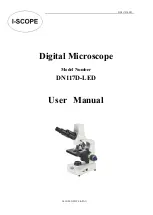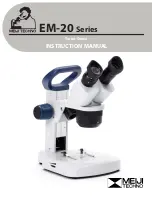
©
Home Training Tools Ltd. 2013 Page 6 of 8
Visit us at ww.homesciencetools.com
Ideas for Using Your Microscope
You have a microscope
—now what? With
the following directions you can get started right
away making your own microscope slides!
How to Make Simple Microscope Slides
Learn more about using the Kids microscope
by making simple slides using common items from
around the house!
Materials Needed:
-
clear Scotch tape
-
a few granules of salt, sugar, ground
coffee, sand, or any other grainy material
Making Simple Slides
To make a slide, tear a 2½-
3” long piece of
Scotch tape and set it sticky side up on the
kitchen table or other work area. Fold over about
½” of the tape on each end to form finger holds on
the sides of the slide. Next, sprinkle a few grains
of salt or sugar in the middle of the sticky part of
the slide.
You can repeat this with the other
substances if you like, just be sure to label each
slide you make with an ink pen or permanent
marker so you w
ill know what’s on the slides!
You can make tape slides with many other
materials as well. Try hair (from pets and family
members), thread and fiber (from carpets or
clothing), or small dead insects such as gnats,
ants, or fruit flies. Label each slide and view them
one at a time with your microscope, experimenting
with different magnification.
How to Make Your Own Prepared Slide
Learn how to make temporary mounts of
specimens and view them with your microscope.
Below are a few ideas for studying different types
of cells found in items that you probably already
have around your house.
Cork Cells
In the late 1600s, a scientist named Robert
Hooke looked through his microscope at a thin
slice of cork. He noticed that the dead wood was
made up of many tiny compartments, and upon
further observation Hooke named these empty
compartments cells. It was later known that the
cells in cork are only empty because the living
matter that once occupied them has died and left
behind tiny pockets of air. You can take a closer
look at the cells, also called lenticels, of a piece of
cork
by
following
these
instructions.
Materials Needed:
-
small cork
-
plain glass microscope slide
-
slide coverslip
-
sharp knife or razor blade
-
water
How to make the microscope slide:
Carefully cut a very thin slice of cork using a razor
blade or sharp knife
(the
thinner
the
slice, the easier it
will be to view with
your
microscope).
To make a wet
mount of the cork, put one drop of water in the
center of a plain glass slide
– the water droplet
should be larger than the slice of cork. Gently set
the slice of cork on top of the drop of water
(tweezers might be helpful for this). If you are not
able to cut a thin enough slice of the whole
diameter of the cork, a smaller section will work.
Take one coverslip and hold it at an angle to
the slide so that one
edge of it touches the
water droplet on the
surface of the slide.
Then, being careful not to move the cork
around, lower the cover slip without trapping any
air bubbles beneath it. The water should form a
seal around the cork. Use the corner of a paper
towel to blot up any excess water at the edges of
the coverslip. To keep the slide from drying out,
you can make a seal of petroleum jelly around the
cover slip with a toothpick. Begin with the lowest-
power objective to view your slide. Then switch to
a higher power objective to see more detail. Use
this same wet mount method for other specimens
such as cheek cells or leaf cells.
Record Your Observations
Our Microscope Observation worksheet (on
the last page) will help you keep track of what you
see and remember what you have learned. Blanks
are provided for recording general information
about each slide (e.g. wet mount stained with
methylene blue). In addition, there is space to
write down your observations and make sketches
of what you see at each magnification level.


























